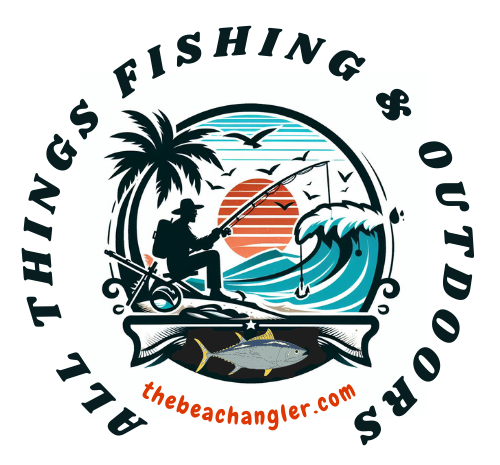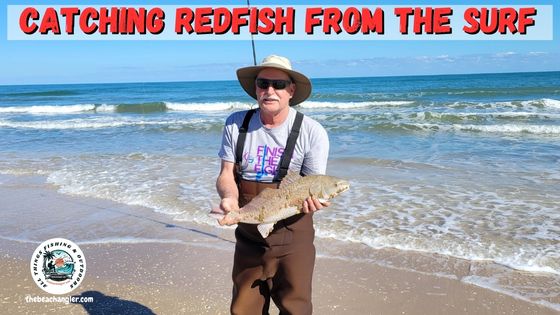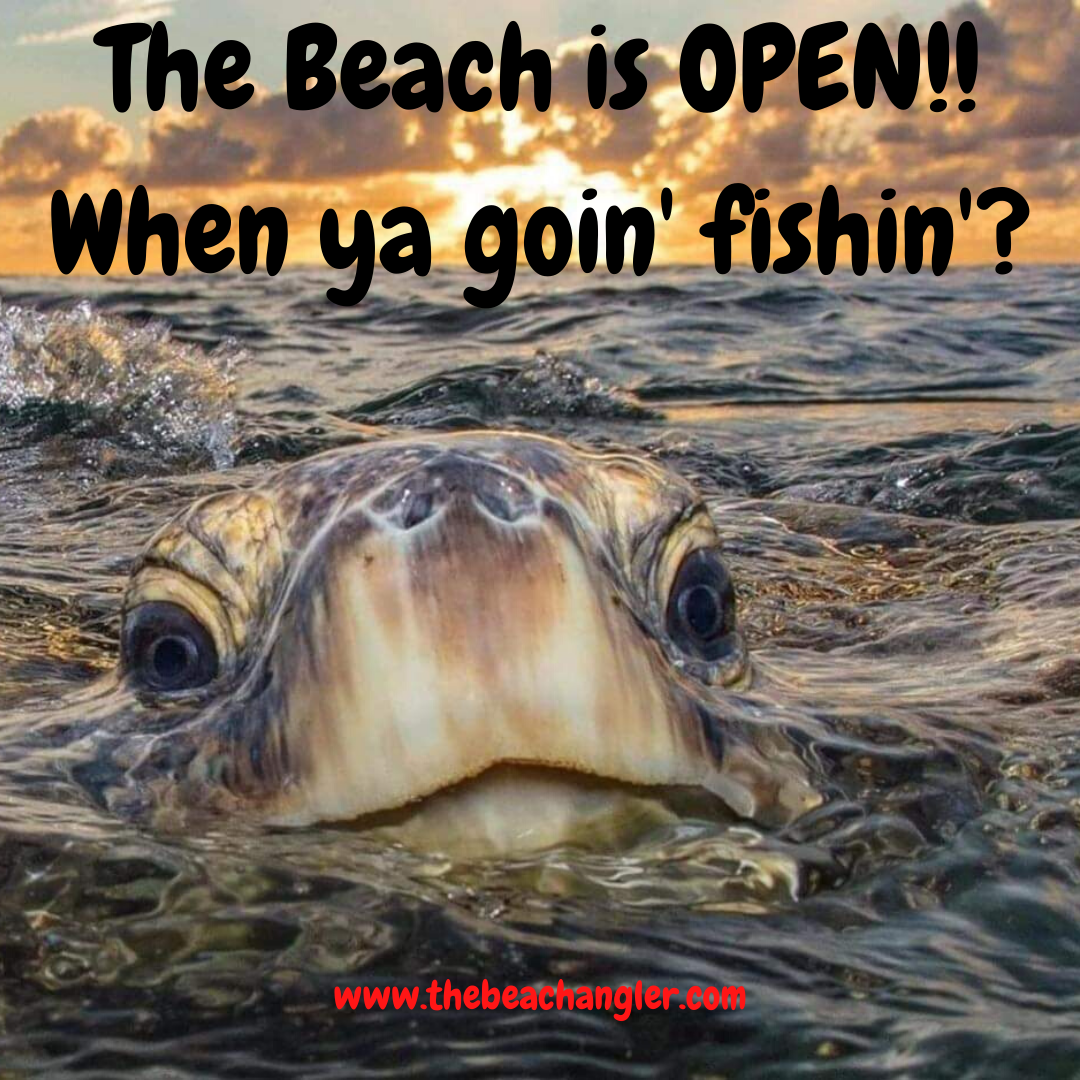Redfish, also known as red drum, are a popular game fish along the Atlantic and Gulf Coasts of the US. They frequent bays, estuaries, offshore structures, and are also common in the surf. However, knowing where to find them and when they’re likely to bite is key to catching them. Follow along and we’ll go over some tips for catching redfish from the surf.
QUICK LOOK: Tips for Catching Redfish from the Surf
- Choose the Right Gear – Proper surf rod and reel, surf rigs, surf weights, and a good 30-pound class braided line.
- Proper Bait – They readily take a variety of natural and artificial baits. Select baits and lures that “match the hatch” by closely resembling what the redfish are currently feeding on.
- Pick the Best Spot – You’ll typically find redfish in and around areas with structures such as sandbars, cuts, rips, and troughs – places where bait tends to gather and where fish like to travel or ambush prey.
Redfish are a hard-fighting and great-eating fish. They readily take a variety of natural and artificial baits. They are also very responsive to changes in the natural rhythms of their environment.
The tides and lunar cycles, for instance, have a significant impact on their movements and feeding habits. It’s common to find redfish feeding actively during high tide when baitfish and crustaceans are abundant in the shallow waters.
Similarly, a full or new moon can result in higher tides, potentially leading to a better fishing experience. Baitfish migrations, changes in water temperature, beach structures, and currents can all have impacts on redfish behavior and feeding activity.
Your success in catching redfish not only depends on being in the right place at the right time but also on having the appropriate gear to capitalize on their predictable behaviors.

Choosing the Right Tackle for Surf Fishing
Redfish are formidable opponents known for their strength and stamina. Selecting your tackle can make a significant difference in your surf fishing success. When you’re aiming for distance to reach the surf zones where redfish feed, the right rod and reel are important.
If you will be throwing artificials in the surf for redfish, I would recommend a medium-heavy surf rod, typically between 7 and 9 feet in length. This range provides a blend of casting distance and control. Paired with a high-capacity spinning reel, you’ll have the casting distance and strength to handle the hard fight and determined runs of surf redfish.
Redfish will take a variety of artificial lures from spoons, plugs, soft plastics, and even topwaters. Talk with the local fishermen and Bait Shops on what is working in your area. Remember, you want to match the hatch whenever possible by choosing lures that resemble what the redfish are feeding on.
If you would rather toss natural baits, you should gear up to a 10 – 12 heavy action surf rod with a 6000 – 8000 series spinning reel spooled with a 30-pound braided line. This added rod length will allow you to cast further with the added weight of your bait and rig, and keep your line above the wave action while waiting for a bite.
Essential Surf Fishing Gear:
- Surf Fishing Rods, surf rods are typically longer and heavier duty than standard rods. – read more.
- Surf fishing Reels,larger and stronger with greater line capacity to handle big fish. – read more.
- Surf fishing Rod and Reel Combos, pre-matched rod and reel set ups for surf fishing – read more.
- Sand Spike Rod holder, holds your rods securely while you wait for that big bite. – read more.
- Surf Fishing Rigs, terminal tackle for fishing the surf. – read more.
- Surf fishing Carts, for beaches that won’t allow vehicles you need a way to carry your gear – read more.
- Rod Racks for Vehicles, carry your rods out of harms way and easy to access- read more.
- Beach Camping Gear, in case you want to fish all night or for several days – read more.
You can use monofilament in the 30-pound class, but the braided line is thinner for the same test so you can hold more line for those long casts and long runs from big fish. For bait rigs, a Carolina rig, fish finder rig, or double drop rig will all do the job.
To keep your bait in place you will need surf weights like the Sputnik, breakaway, or spider weight. These anchor your rig to the bottom and prevent the currents and waves from washing it down the beach.
Selecting Effective Baits and Lures
Redfish aren’t picky eaters, but using what they’re actively feeding on will significantly increase your catch rate. Let’s talk about live bait first. Live bait such as mullet, shrimp, and crabs are natural prey for redfish and can be particularly effective. When using live bait, make sure it’s fresh and lively and that you have some live bait storage to keep it alive during your trip.
Fresh dead and cut bait will work well for redfish as well. And, it is easier to keep and store without needing an aerated live bait well full of sloshing saltwater as you travel the often bumpy beach. 😉
Artificial lures are also an excellent choice for redfish, but it’s vital to match the lure to the conditions. On cloudy days or in murky water, bright and noisy lures can be beneficial since redfish rely more on their other senses to find food.
In contrast, more natural and subtle lures will work best in clear conditions. Spoon lures, soft plastics, and topwater plugs have all been known to be effective, depending on the behavior of the fish and the environment.
Synthetic baits such as Berkley PowerBait, Berkley Gulp, or Fishbites strip baits are all good choices for catching redfish from the surf. They keep well, require no special handling, and will flat-out catch fish.
Always pay attention to what’s happening around you and adjust your tactics accordingly. If you notice baitfish jumping, a lure that closely resembles those bait fish and these frantic movements can be irresistible to a redfish.
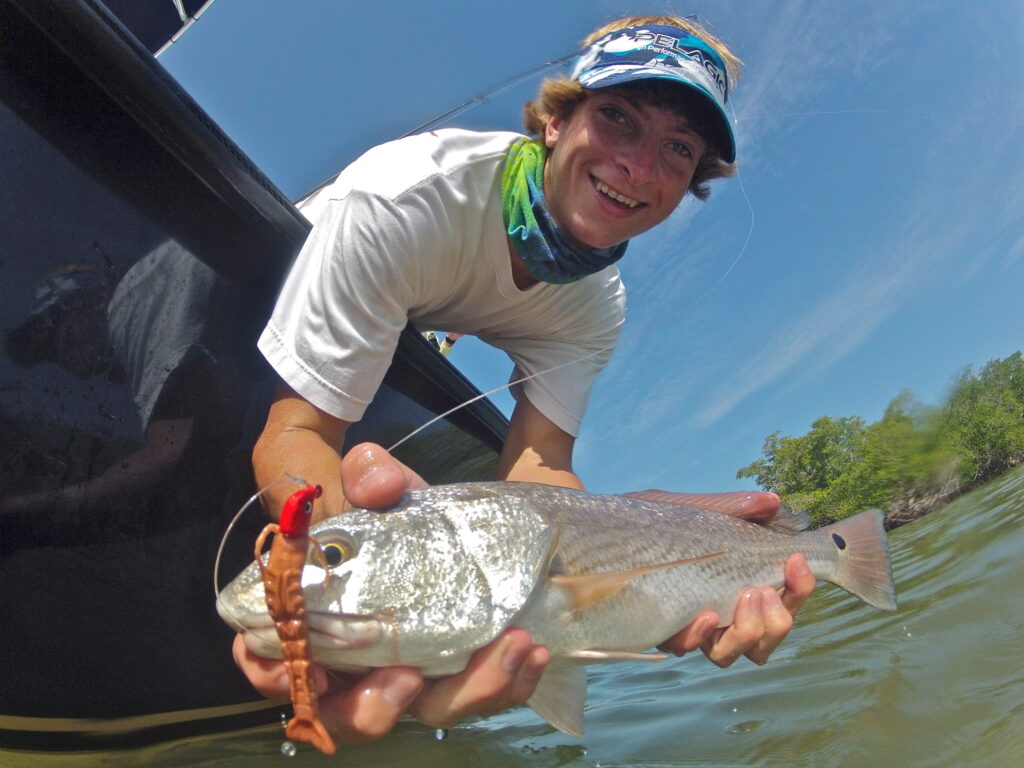
Experimentation is key, as what works one day might not work the next, due to changes in weather, tide, or redfish feeding patterns. Change your retrieve and, if that doesn’t work, change your lures until you find what the fish want. If and when you find that sweet spot, you can have nonstop action catching redfish from the surf.
Finding the Best Locations for Catching Redfish from the Surf
So what are the prime areas to target for catching redfish from the surf?
You’ll typically find redfish in and around areas with structures such as sandbars, cuts, rips, and troughs – places where bait tends to gather and where fish like to travel or ambush prey.
Now, reading the surf is an art in itself. You need to be able to spot the signs of troughs, rips, cuts, and sandbars. Watch the waves breaking and notice where they break and where they don’t. This will give you a good indication of changes in water depth and the presence of sandbars.
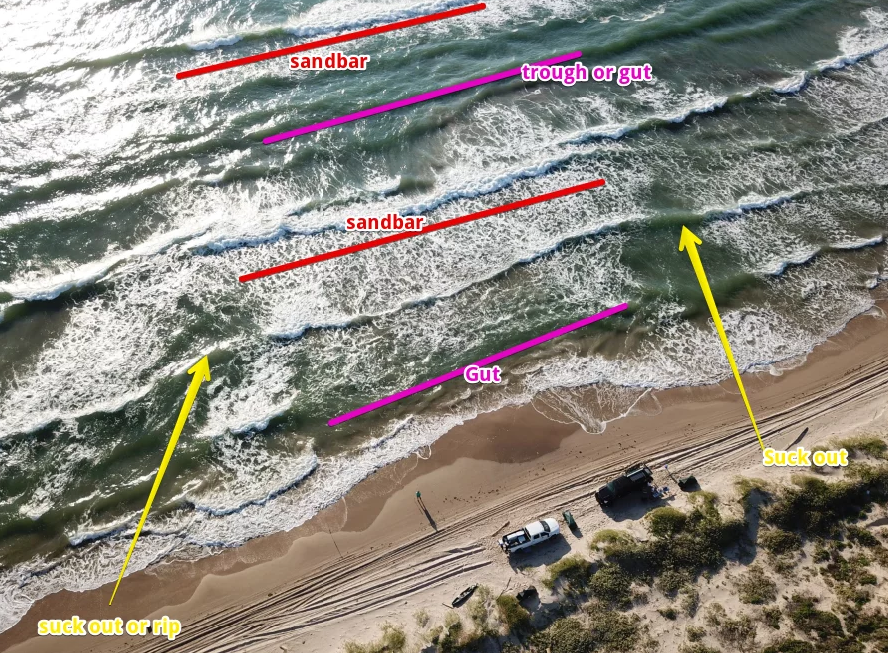
Look for deeper guts and holes on the down-current side of a rip or cut in the sandbar. Then position your bait here, and you’re in a prime location to find feeding redfish. Always be on the lookout for signs of bait. If the bait is there, likely redfish are there as well. Watch for birds diving into the water; they are feeding on bait and can be indicators of a feeding frenzy below.
This often means redfish, and other predators, are feeding on the bait and driving it to the surface where the birds can get in on the action. Tossing artificials under feeding birds can result in some fast and furious action. I always keep one rod rigged with artificials to be ready in case I run into birds working the beachfront.
Mastering Casting Techniques for Surf Fishing
Proper surf casting isn’t just about strength; it’s about technique. So don’t worry too much about launching your bait a country mile on your first try. For starters, the stance and motion are crucial. Maintain a balanced posture with your feet shoulder-width apart, and use your whole body when you cast, not just your arms.
It’s a fluid motion, like swinging a baseball bat, where your hips and shoulders do much of the work. Watch the following video to see how it works in action. Try it out at home before you hit the beach. Practice with nothing but a weight on your line and get comfortable with the motion and the action of your rod.
Responsible Fishing Practices and Regulations
While catching redfish can be thrilling, maintaining a healthy population for future generations is paramount. First, ensure you’re up to speed with local regulations, which include legal size and bag limits for redfish. These rules are in place to prevent overfishing and to help manage the population sustainably.
When catching redfish from the surf, please practice safe catch and release of over and undersized redfish. This will help support the conservation of redfish as a species. By carefully handling redfish and using the right equipment, like circle hooks that minimize harm, you contribute to their survivability post-release.
Frequently Asked Questions on Catching Redfish from the Surf

What baits work best for catching redfish from the surf?
Fresh shrimp, crab knuckles, Fishbites, and mullet or cut bait are fantastic baits for redfish in the surf.
How do I find the best spots to catch redfish from the surf?
Identify beach structure by looking for troughs and sandbars as you walk along the beach. Redfish can be in shallow water very close to shore, so cast your baits in different places to find their feeding zone.
What rigs should I use for catching redfish from the surf?
Use a double dropper rig with a Sputnik sinker to determine where in the water column redfish are feeding (higher or lower). A fish finder rig is great for live baitfish and cut bait, keeping your bait on the bottom.
Can I catch redfish on artificial lures in the surf?
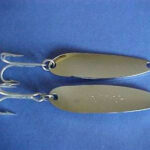
Yes! Sight-cast for redfish using clean water and calm conditions. Cast parallel to the beach and retrieve the lure in front of cruising redfish. Gold or silver spoons create great flash, and a Slam Shady on a jig head works well too.
What time of day is best for catching redfish from the surf?
Early morning and late afternoon are prime times. Redfish are more active during these periods, especially during rising tides. However, they can be caught throughout the day if conditions are favorable.
What size hooks should I use for redfish in the surf?
For cut bait or live bait, use circle hooks in the 2/0 to 4/0 range. Circle hooks are effective because they tend to hook the fish in the corner of the mouth, reducing mortality rates when catch-and-release fishing.
How do I handle redfish safely after catching them?
Wet your hands before handling redfish to protect their slime coat. Hold them gently by the lower jaw or use a lip gripper. Avoid touching their gills or eyes. If you’re releasing the fish, revive it by gently moving it back and forth in the water until it swims away strongly.
What’s the best way to cast for redfish from the beach?
Use a sidearm or overhead cast to cover more distance. Aim for the deeper water beyond the sandbar or trough. Be patient and let your bait settle before retrieving. Redfish often feed close to shore, so don’t cast too far out.
Find a Beach and Start Catching Redfish from the Surf
Now it’s time to go fishing. Check out the local bait shops and online fishing forums. Pick out a likely beach, grab your gear, and try your hand at catching redfish from the surf. If you’ll keep these tips in mind, and learn from each cast and fishing trip, you will be catching redfish from the surf in no time.
Recent Articles
- Tips For Fishing In Different Weather Conditions
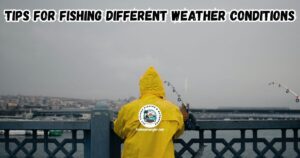
- 5 Revolutionary Features of the Minn Kota Riptide Instinct Quest Series Trolling Motor

- 5 Features The Z-Man HerculeZ Swimbait
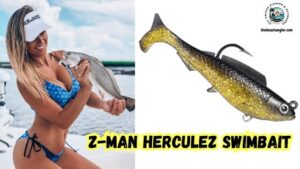
- 7 Tips for Fishing Gulf Of Mexico Nearshore Rigs In Texas

- 6 Top Features of Okuma Hakai Baitcast Reels
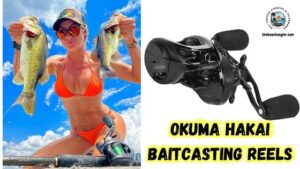
- The Daiwa Lazy Fashad

As always, stay safe, enjoy the journey and please try to leave it cleaner than you found it. If you have any comments, questions, ideas, or suggestions please leave them in the comment section below and I’ll get back to you ASAP. You can follow us on Facebook: Rex The Beach Angler, Instagram: thebeachangler7, Twitter: @AnglerBeach, and YouTube: Man Art Creations.
P.S. – Thanks so much for checking out our blog we really appreciate it. Just so you know, we may receive a commission if you click on some of the links that appear on our site. This helps us keep our content free and up-to-date for everyone. We appreciate your support!
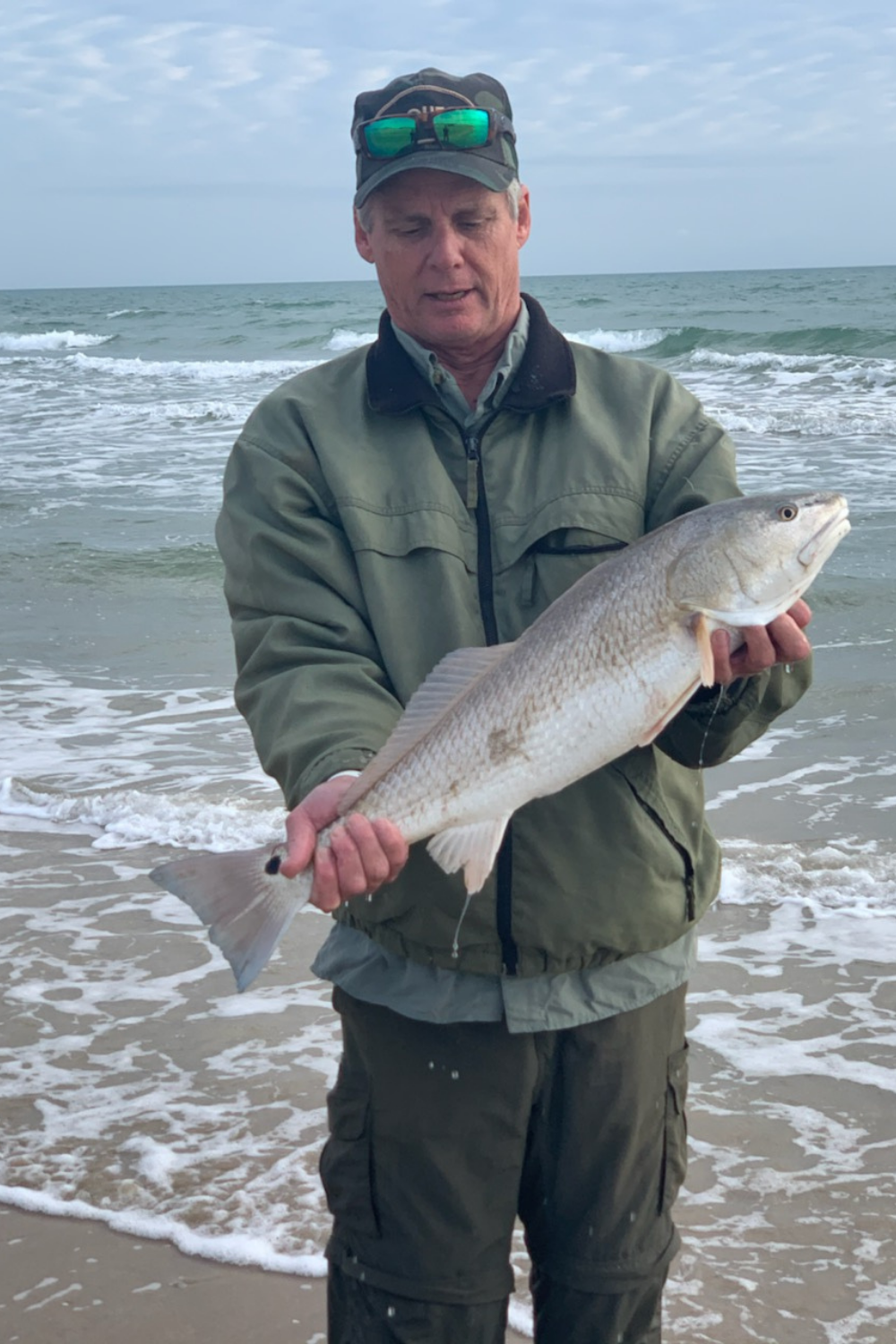
A life long surf fisherman with 50+ years of experience, I am also an avid hunter and outdoorsman. I will be sharing my passion for the outdoors with you so be prepared for hunting, fishing, camping, hiking and more. Along with gear reviews and the latest trends and innovations in the outdoor industry.
